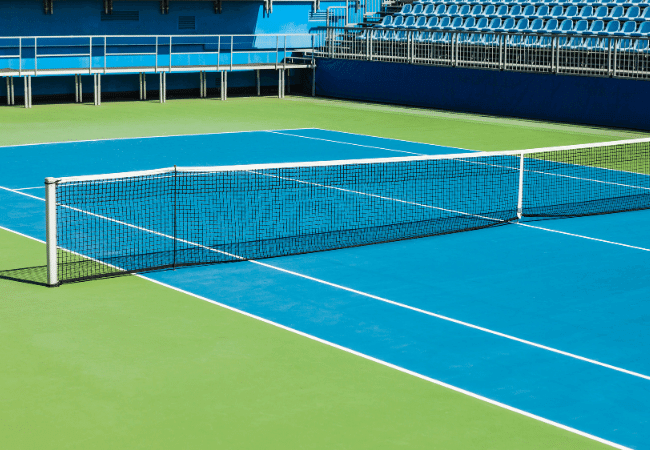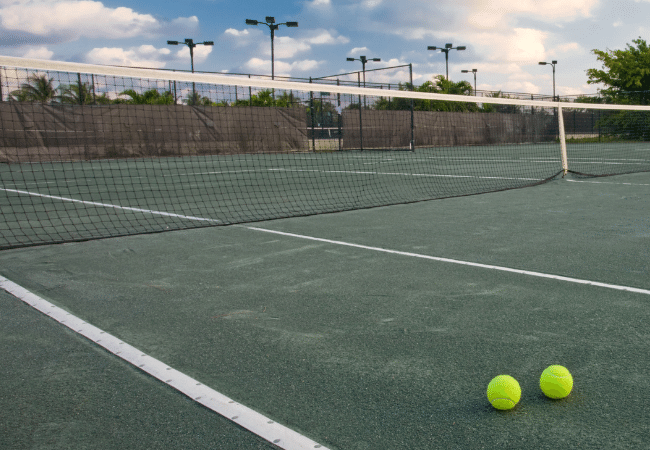Drive by any high school and many local parks and you’re likely to see at least one outdoor tennis court. Usually it’s a hard court. What are the other tennis court surfaces?
Does surface type impact your game and your body? (The answer to this is YES!)
What are the pros and cons of each tennis court surface? Let’s take a look…
Contents
Hard Courts

Hard courts are the most widely available court surface in the United States. They’re relatively easy to install and won’t break the bank to do so. If you have the backyard space, you can make tennis court construction be a DIY project if you’re so inclined.
They have very little in the way of maintenance so they’re in the realm of “set it and forget it” tennis surface.
The speed of play is medium to fast paced and the ball bounce is relatively consistent.
A downside to the hard court surface is that they can be very rough on your joints with the consistent pounding on the unforgiving playing surface. Knee problems aren’t uncommon for those who spend a lot of time on hard courts.
Due to faster bounces, tennis players need to be more mobile to react to quick shots. If quick movements aren’t your forte, hard courts may not be for you.
The Australian Open is one Grand Slam tournament where hard courts are in use. The other one is the US Open. This tennis surface appeals to many tennis players with faster serves and punishing returns.
Why are Many Hard Courts Now Blue?
The US Open debuted blue hard courts in 2005. They did so to provide better visibility for the players, fans, and tv cameras.
Other tournaments took note and now many more hard courts are also blue.
Clay Courts

Red clay courts aren’t found much in the United States. They’re more likely to be found in Europe or South America.
We’ve all seen Spaniards and Brazilians tear it up at the French Open on the slow-paced natural clay surface with their loopy groundstrokes and 20+ stroke rallies.
Balls may bounce higher, but a red clay tennis court eats up a lot of the pace, so balls sit up and allow players to take a crack out of them.
In the United States you’re more likely to find Har-Tru courts – a green clay surface found predominantly in the south eastern portion of the country.
Per Har-Tru, the recognizable color comes from “pre-Cambrian metabasalt found in the Blue Ridge Mountains of Virgina.”

Playing on a har tru court will be much cooler temperature wise than a hard court. It’s also a much softer surface so the risk of injury is reduced.
A clay court is not expensive to install, but the expense occurs with the long-term maintenance.
These courts must be watered and brushed on a daily basis, and must be rolled periodically to maintain the level playing surface.
Some view the slow playing conditions on clay as a disadvantage, but that opinion is just personal preference.
Grass Courts

Tennis began on grass courts, but they aren’t nearly as common today.
The first place that comes to mind when I think of a grass tennis court is Wimbledon. The All England Lawn Tennis Club is where Wimbledon occurs each year. It’s the only Grand Slam tournament held on natural grass.
While the name of the club has had varying names over the years, the grass surface has always been the court surface of choice. It’s tradition.
Maintaining grass courts is arduous and expensive. Planting the grass. Mowing to certain specifications. Watering. It’s a lot of work and beyond the scope of most clubs for what they do for their tennis programs.
Most tennis players won’t ever play on a grass court due to lack of availability. If there were able to, they’d see how quickly the ball comes at them and how much they have to bend their knees because the bounce is so low.
The ball tends to skid off the ground rather than definitively bounce up.
Grass is also notorious for being quite delicate. A few matches played on a court and the bounce is quite inconsistent.
We’ve seen many a player at Wimbledon go down on the court as the grass is quite slick.
Modular Tennis Court Surfaces?
Similar to hard courts, modular court surfaces have become more popular in recent years.
You can order a kit for many court types and it’ll arrive at your home ready to be installed using interlocking tiles.
Modular court surfaces (aka sport courts) are known for being low maintenance, durable, and shock absorbing. They can also be customized to be only a singles court (no doubles alleys) or constructed in various colors.
Modular surfaces can do double, triple or quadruple duty with other court games (basketball, pickleball, volleyball, etc).
These modular surface court systems may last a long time, but the brightly installed colors will fade after years in the sun. The interlocking design works well for them to stay together, but leaves and debris will find their way into the many cracks between each tile.
Determining Your Best Surface
Most tennis players have a favorite playing surface. I grew up playing tennis on hard courts, but now definitely prefer Har-Tru courts.
I like to slide into shots and appreciate the har tru court surface being a little kinder to my body. Coming home with clay all over my shoes, bag, and legs may not be fun, but I prefer the playing experience. I’ll leave the fast courts to my youth!
Figuring out your favorite court surface will probably take into consideration court speed and ball bounce. Do you like a hard court surface with a fairly predictable bounce, a clay court with its slower playing speed, or a grass court where anything is possible?
Of the different tennis court surfaces, which is your favorite?

